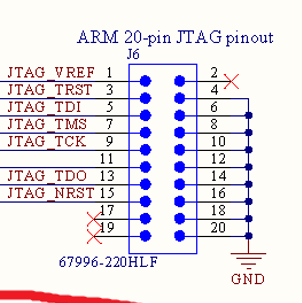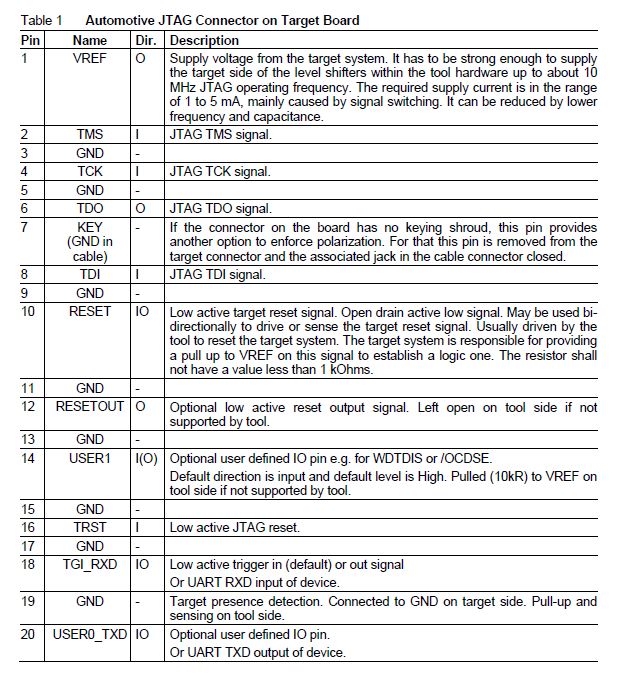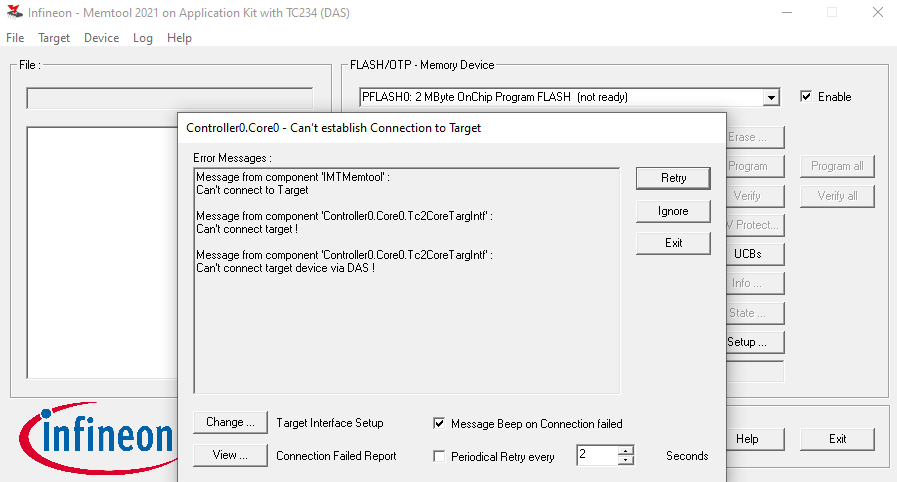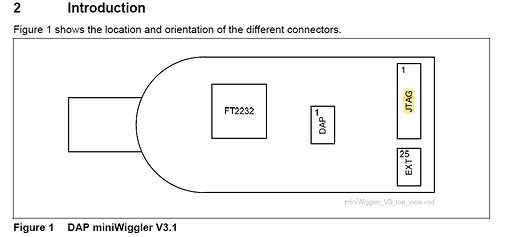I own both the CW Lite and the CW 1200. I also got the UFO Target board and recently bought the Aurix Target Board. How do I set it up from scratch to perform a simple testing AES CPA attack on it? Can I still use my old code from the notebooks? I see that I need to download a Tricore toolchain to build projects (I assume the same projects as in the CPA tutorials?). Do I need to modify the code somehow to set up a trigger signal? I am kind of lost here
Follow the instructions for building and programming here:
I would expect that our AES tutorials should “just work” if you’re using the same tinyaes implementation (i.e. building with make PLATFORM=CW308_AURIX CRYPTO_TARGET=TINYAES128C).
Glitch tutorials will be interesting if you enable the lockstep core.
I have bought the infineon miniwiggler v3 but it doesnt contain a 20pin adapter, the wiggler has smaller pins than the ones from the CW Target Board. How can I fix that problem?
@jpthibault I did try to connect the wires by myself, although I cannot find the nRST from CW308 PIN on the Infineon Miniwiggler PINs, which one could it be?

I think it would be pin 10.
I created an adapter for the JTAG between miniwiggler and cw308, although I get following message when I try to connect the target via memtool:
What could cause the problem? Are there other effective ways to program the aurix chip to make it compatible with the jupyter notebooks?
The report:
----------------------------------------------------------
Connection Failed Report from
Infineon Memtool Target Interface, Version: 1.19.9
created: 05/05/22, 11:48:54
----------------------------------------------------------
Windows version:
Win8 ()
Admin: yes
IMT version:
Release: 2021.05
Build: 5005
Path: C:\Program Files\Infineon\Memtool 2021
Target configuration file:
C:\Users\Documents\Infineon\IMT 2021\Targets\AppKit_TC234_das.cfg
Error messages:
Controller0.Core0.Tc2CoreTargIntf: Can't connect target !
Controller0.Core0.Tc2CoreTargIntf: Can't connect target device via DAS !
Settings:
PortType: DAS
CommDevSel:
TargetPort: Default
TargetPortId: 553582592
DasIsDefault: n
MaxJtagClk: 10000
CheckJtagId: y
ScanJTAG: n
Ocds1ViaPod: n
EtksArbiterMode: None
EtksWaitAfterArbitrationTime: 0
RefreshJtag: n
RefreshHarr: n
ReenableOcds: y
ReduceJtagClock: n
UseDap: n
DapMode: 2PIN
JtagMuxPort: -1
UseNewJtagEngine: y
ConnOption: Default
SetDebugEnableAb1DisablePin: n
ResetWaitTime: 500
ResetMode: Default
OpenDrainReset: n
DiswdtOnReset: n
ExecInitCmds: y
InitScript Script:
; Workaround for TLF35584 B/C-Step Bug
# QSPI2_CLC: Enable QSPI module. DISR=0,EDIS=1
SET 0xF0001E00 0x8
# QSPI2_GLOBALCON: Set the Global time quantum and Expect phase timeout in GLOBALCON register.
# Also, enable Master mode. MS=0, STROBE=15, EXPECT=12, TQ=0
SET 0xF0001E10 0xF3000
# QSPI2_PISEL: Select the Master Mode Receive Input in the PISEL register. Here, it is
# input A (MRST0A). MRIS=0
SET 0xF0001E04 0x0
# QSPI2_GLOBALCON1: Enable the Single Move Mode in the GLOBALCON1 register.
# TXFM=1, RXFM=1
SET 0xF0001E14 0x14050000
# QSPI2_ECON1: Enable Parity, and set values for Q, B and C fields in the ECON4 register
#(since chip-select output 1, SLSO21 is used here). PAREN=1, C=0, B=2, A=1, Q=9
SET 0xF0001E24 0x4249
# QSPI2_SSOC: Enable the slave select output (Here SLSO21) and make the corresponding
# signal active level low, in the SSOC register. OEN=0x80, AOL=0
SET 0xF0001E48 0x00020000
# P14_IOCR0: P14.2=SLSO21;
SET 0xF003B410 0x00980000
# P15_IOCR0: P15.3=SCLK2;
SET 0xF003B510 0x98000000
# P15_IOCR4: P15.5=MTSR2, P15.7=MRST2B
SET 0xF003B514 0x00009800
# QSPI2_FLAGSCLEAR
SET 0xF0001E54 0xFFF
# QSPI2_BACONENTRY: In the BACON register: Set the current frame as the last frame, and data
# length in bits (Short frame mode). Data length is 15 bits + parity, MSB is shifted
# first. The channel is selected properly (Here, channel 1 for SLSO21) Set
# the trailing delay. CS=QSPI_SLSO,DL=14,BYTE=0,MSB=1,UINT=0,PARTYP=0,TRAIL=0,
# TPRE=3,LEAD=0,LPRE=3,IDLE=0,IPRE=3,LAST=1
SET 0xF0001E60 0x17206187
# QSPI2_GLOBALCON: Put the QSPI module to RUN state. MS=0, STROBE=15, EXPECT=12, TQ=0, EN=1
SET 0xF0001E10 0x010F3000
# QSPI2_DATAENTRY0: Write w parity 0x43AB,0x43EF,0x4356,0x4312,0x4693,0x4500,0x43DF,0x4334,0x43BE,0x43CA
# UNLOCK1
SET 0xF0001E64 0x43AB
# QSPI2_FLAGSCLEAR: Clear TX flag. TXC=1
SET 0xF0001E54 0x200
# QSPI2_FLAGSCLEAR: Clear RX flag. RXC=1
SET 0xF0001E54 0x400
# QSPI2_DATAENTRY0: UNLOCK2
SET 0xF0001E64 0x43EF
# QSPI2_FLAGSCLEAR: Clear TX flag. TXC=1
SET 0xF0001E54 0x200
# QSPI2_FLAGSCLEAR: Clear RX flag. RXC=1
SET 0xF0001E54 0x400
# QSPI2_DATAENTRY0: UNLOCK3
SET 0xF0001E64 0x4356
# QSPI2_FLAGSCLEAR: Clear TX flag. TXC=1
SET 0xF0001E54 0x200
# QSPI2_FLAGSCLEAR: Clear RX flag. RXC=1
SET 0xF0001E54 0x400
# QSPI2_DATAENTRY0: UNLOCK4
SET 0xF0001E64 0x4312
# QSPI2_FLAGSCLEAR: Clear TX flag. TXC=1
SET 0xF0001E54 0x200
# QSPI2_FLAGSCLEAR: Clear RX flag. RXC=1
SET 0xF0001E54 0x400
# QSPI2_DATAENTRY0: WWD off
SET 0xF0001E64 0x4693
# QSPI2_FLAGSCLEAR: Clear TX flag. TXC=1
SET 0xF0001E54 0x200
# QSPI2_FLAGSCLEAR: Clear RX flag. RXC=1
SET 0xF0001E54 0x400
# QSPI2_DATAENTRY0: ERR-pin monitoring off
SET 0xF0001E64 0x4500
# QSPI2_FLAGSCLEAR: Clear TX flag. TXC=1
SET 0xF0001E54 0x200
# QSPI2_FLAGSCLEAR: Clear RX flag. RXC=1
SET 0xF0001E54 0x400
# QSPI2_DATAENTRY0: LOCK1
SET 0xF0001E64 0x43DF
# QSPI2_FLAGSCLEAR: Clear TX flag. TXC=1
SET 0xF0001E54 0x200
# QSPI2_FLAGSCLEAR: Clear RX flag. RXC=1
SET 0xF0001E54 0x400
# QSPI2_DATAENTRY0: LOCK2
SET 0xF0001E64 0x4334
# QSPI2_FLAGSCLEAR: Clear TX flag. TXC=1
SET 0xF0001E54 0x200
# QSPI2_FLAGSCLEAR: Clear RX flag. RXC=1
SET 0xF0001E54 0x400
# QSPI2_DATAENTRY0: LOCK3
SET 0xF0001E64 0x43BE
# QSPI2_FLAGSCLEAR: Clear TX flag. TXC=1
SET 0xF0001E54 0x200
# QSPI2_FLAGSCLEAR: Clear RX flag. RXC=1
SET 0xF0001E54 0x400
# QSPI2_DATAENTRY0: LOCK4
SET 0xF0001E64 0x43CA
# QSPI2_FLAGSCLEAR: Clear TX flag. TXC=1
SET 0xF0001E54 0x200
# QSPI2_FLAGSCLEAR: Clear RX flag. RXC=1
SET 0xF0001E54 0x400
; switch off FLASH error traps
SET 0xF80020A8 0x8000
SET 0xF80020AC 0x8000
ExecOnConnectCmds: n
OnConnectScript Script:
Script is empty
ExecOnExtRstCmds: n
ResetPulseLen: 10
AddResetDelay: 0
UseTrstOnReset: n
ExecEmemInitOnReset: 0x00000000
SimHsmBootEnabled: n
UnlockInterface: n
BootPasswd0: 0x00000000
BootPasswd1: 0x00000000
BootPasswd2: 0x00000000
BootPasswd3: 0x00000000
BootPasswd4: 0x00000000
BootPasswd5: 0x00000000
BootPasswd6: 0x00000000
BootPasswd7: 0x00000000
PasswordFile:
UnlockInterfaceDelay: -1
HandleBmiHeader: n
SetAutOkOnConnect: n
DontUseWdtSusp: n
InitCore0RamOnConnect: n
IgnoreFailedHaltAfterResetOnConnect: n
TrySystemResetAfterFailedHardwareReset: n
RunStabilityTestOnConnect: n
RunStabilityTestCycles: 10
IgnoreFailedEnableOcdsOnConnect: n
UseLbistAwareConnect: n
MaxTry: 1
ForceEdMode: -1
UseDflashAccessFilter: y
DetectResetWhileHalted: y
UseTranslateAddr: y
DownloadToAllRams: y
HaltAfterReset: y
HaltAfterHardwareReset: n
TargetAppHandshakeMode: None
TargetAppHandshakeTimeout: 100
TargetAppHandshakeParameter0: 0x00000000
TargetAppHandshakeParameter1: 0x00000000
TargetAppHandshakeParameter2: 0x00000000
TargetAppHandshakeParameter3: 0x00000000
ConvertSuspendSignalToPulse: n
SimioAddr: g_JtagSimioAccess
UseStmForPtm: 1
ExecOnStartCmds: n
OnStartScript Script:
ExecOnHaltCmds: n
OnHaltScript Script:
ExecOnHaltCmdsWhileHaltedPeriod: 0
UseTriggerToBreak: y
UseTL2OnHalt: y
UseOstateStable: y
AllowJtagResetWhileRunning: y
MaxAccRetry: 1
AccRetryDelay: 10
DefOcdsReserved:
UseRestartWhileRunningHandling: n
DebugResetOnDisconnect: n
IgnoreEmemAccessErrors: n
RemapEmemAccess: n
EnableAutomaticHsmStart: n
EnableAutomaticHsmRunControl: n
ReadPmcsrWhileRunning: y
MultiChipDbgMode: 0
MultiChipDbgInp: 1
MultiChipDbgOut: 6
MultiChipDbgCtl: 7
IgnoreShortHalt: n
HaltOnBreakOnly: n
IvIcacheOnHalt: y
IvPlbOnHalt: y
SuspendSlaveCores: n
FilterMemAcc: y
DasDllPath: das_api.dll
DasHost:
DasTryStartSrv: y
DasSrvPath: servers\udas\udas.exe
DasStopSrv: y
DasResetHelperBreakAddr: main
DasResetMode: 2
DasRemoveLogFile: n
DasForwardSerNum: n
DasSrvSel: -1
DasPortType: 0
DasPortSel: 0
DasCmdTimeout: 1000
DasWaitAfterConnect: 0
DasDisconnectSrv: n
DasResetDelay: 0
DasWaitAfterGo: 0
DasApiLogging: n
GoExtOption:
DontUseTriggerLines: n
DontUseSingleStep: n
JTAG target infos:
JTAG-ID: 0x00000000
UsedJtagClk: 0 MHz
ExtVoltage: 0.0 V
IntVoltageUsed: n
CHIPID: 0x00000000
STSTAT: 0x00000000
DAS related information:
DAS DLL Version:
Server started by UDE: C:\Program Files\DAS64\servers\udas\udas.exe
Server name: UDAS
Server manufacturer: Infineon
Server version: V3.11
DAS-API version: V4.2
Server lib version: V3.0
last DAS error: 4
last DAS function: connect_to_device
Hi,
Using one of these: https://www.digikey.ca/en/products/detail/olimex-ltd/ARM-JTAG-20-10/3471401, I’m able to connect. Which connector on the programmer are you using? The correct one is the 10-pin connector closest to the QFP.
Alex
I have connected the 20pin JTAG from the miniwiggler into 20pin JTAG on the CW308(actually only 9 pins). The one you mean is the DAP connector on the miniwiggler which contains 10pins? If yes, how do I know which pins from the miniwiggler DAP belong to which pins on the 20 JTAG of CW308, so I can create a new adapter? I cant find it in the infineon documentation
Yup, the DAP connector is correct. The schematic for the connector that I’m using is available here: https://www.olimex.com/Products/ARM/JTAG/ARM-JTAG-20-10/resources/ARM-JTAG-20-10-schematic.pdf
Alex
alright, Ill try it out, although why doesnt it work through the 20pin JTAG? Do I need to activate it somehow?
I’m not sure why it doesn’t work through JTAG, sorry.
Do I need to use HighTec’s Tricore Tool Chain to create projects for CW? I just created the .hex file using the jupyter notebook (just as in every other case before) and flashed it via the wiggler. Am I missing something here?
So long as tricore-gcc and the other tools are on your PATH, that should be right.


